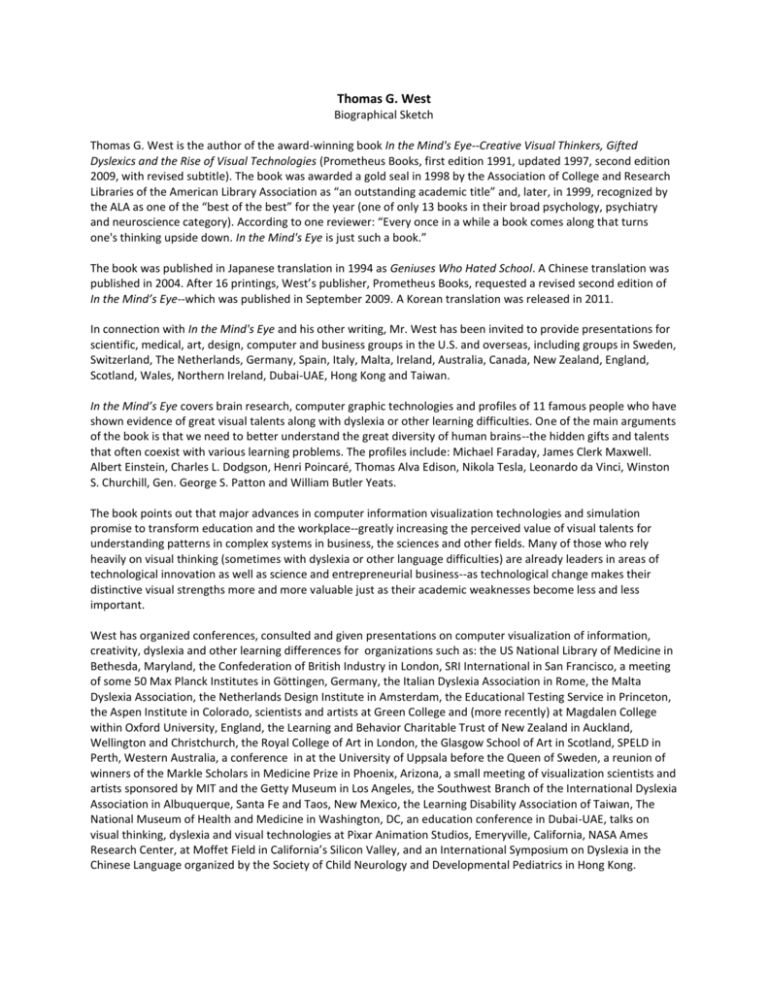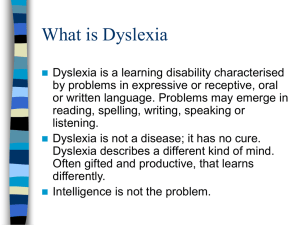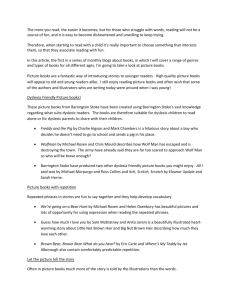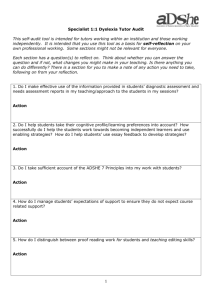Thomas G. West - Landmark College
advertisement

Thomas G. West Biographical Sketch Thomas G. West is the author of the award-winning book In the Mind's Eye--Creative Visual Thinkers, Gifted Dyslexics and the Rise of Visual Technologies (Prometheus Books, first edition 1991, updated 1997, second edition 2009, with revised subtitle). The book was awarded a gold seal in 1998 by the Association of College and Research Libraries of the American Library Association as “an outstanding academic title” and, later, in 1999, recognized by the ALA as one of the “best of the best” for the year (one of only 13 books in their broad psychology, psychiatry and neuroscience category). According to one reviewer: “Every once in a while a book comes along that turns one's thinking upside down. In the Mind's Eye is just such a book.” The book was published in Japanese translation in 1994 as Geniuses Who Hated School. A Chinese translation was published in 2004. After 16 printings, West’s publisher, Prometheus Books, requested a revised second edition of In the Mind’s Eye--which was published in September 2009. A Korean translation was released in 2011. In connection with In the Mind's Eye and his other writing, Mr. West has been invited to provide presentations for scientific, medical, art, design, computer and business groups in the U.S. and overseas, including groups in Sweden, Switzerland, The Netherlands, Germany, Spain, Italy, Malta, Ireland, Australia, Canada, New Zealand, England, Scotland, Wales, Northern Ireland, Dubai-UAE, Hong Kong and Taiwan. In the Mind’s Eye covers brain research, computer graphic technologies and profiles of 11 famous people who have shown evidence of great visual talents along with dyslexia or other learning difficulties. One of the main arguments of the book is that we need to better understand the great diversity of human brains--the hidden gifts and talents that often coexist with various learning problems. The profiles include: Michael Faraday, James Clerk Maxwell. Albert Einstein, Charles L. Dodgson, Henri Poincaré, Thomas Alva Edison, Nikola Tesla, Leonardo da Vinci, Winston S. Churchill, Gen. George S. Patton and William Butler Yeats. The book points out that major advances in computer information visualization technologies and simulation promise to transform education and the workplace--greatly increasing the perceived value of visual talents for understanding patterns in complex systems in business, the sciences and other fields. Many of those who rely heavily on visual thinking (sometimes with dyslexia or other language difficulties) are already leaders in areas of technological innovation as well as science and entrepreneurial business--as technological change makes their distinctive visual strengths more and more valuable just as their academic weaknesses become less and less important. West has organized conferences, consulted and given presentations on computer visualization of information, creativity, dyslexia and other learning differences for organizations such as: the US National Library of Medicine in Bethesda, Maryland, the Confederation of British Industry in London, SRI International in San Francisco, a meeting of some 50 Max Planck Institutes in Göttingen, Germany, the Italian Dyslexia Association in Rome, the Malta Dyslexia Association, the Netherlands Design Institute in Amsterdam, the Educational Testing Service in Princeton, the Aspen Institute in Colorado, scientists and artists at Green College and (more recently) at Magdalen College within Oxford University, England, the Learning and Behavior Charitable Trust of New Zealand in Auckland, Wellington and Christchurch, the Royal College of Art in London, the Glasgow School of Art in Scotland, SPELD in Perth, Western Australia, a conference in at the University of Uppsala before the Queen of Sweden, a reunion of winners of the Markle Scholars in Medicine Prize in Phoenix, Arizona, a small meeting of visualization scientists and artists sponsored by MIT and the Getty Museum in Los Angeles, the Southwest Branch of the International Dyslexia Association in Albuquerque, Santa Fe and Taos, New Mexico, the Learning Disability Association of Taiwan, The National Museum of Health and Medicine in Washington, DC, an education conference in Dubai-UAE, talks on visual thinking, dyslexia and visual technologies at Pixar Animation Studios, Emeryville, California, NASA Ames Research Center, at Moffet Field in California’s Silicon Valley, and an International Symposium on Dyslexia in the Chinese Language organized by the Society of Child Neurology and Developmental Pediatrics in Hong Kong. In 2006, West was invited to travel to the UK to be the main speaker at the “Diversity Day” conference for the code-making and code-breaking descendants of Bletchley Park (World War II code breakers). It was the first ever diversity day for the staff of GCHQ (Government Communications Headquarters) near Cheltenham, England. Among the many brilliant linguists, mathematicians, engineers, analysts, scientists and technologists employed at GCHQ, there are a number of individuals with dyslexia, ADHD, dyspraxia or Asperger syndrome--indicating that it is not unusual to find some form of learning difficulty coexisting with certain high talents and capabilities. All of this used to be top secret at GCHQ. However, recently, organizational pride in their diversity support policies for “different thinkers” has resulted in talking publicly and listing their accomplishments on the GCHQ website. More recently, GCHQ spokesmen said publicly that dyslexics are their “secret weapon against terrorists” since they are able to “see the pattern with only two pieces of the puzzle (July 2013).” Notable invited talks in 2010 and 2011 have included a talk at Oxford University, two talks for the Malta Dyslexia Association and a talk given at the University of California at Berkeley. The main theme of these talks was: “Dyslexic Talents, Engines of Discovery.” West was also invited to make a presentation at the Harvard/MIT Learning & the Brain conference on “Preparing Students’ Minds for the Future” in Boston, in November 2011, with the Harvard Graduate School of Education and the Martinos Imaging Center at MIT. West was asked to discuss his book In the Minds Eye—and, specifically, how those with learning differences might benefit from their gifts and talents, such as visual and creative thinking, in the technological 21st century rather than being considered as having certain deficits only. The overall conference had been organized to explore the cognitive abilities and skills that will be necessary for students to succeed in the 21st century—and how those with diverse learning differences such as dyslexia and ADHD along with the highly gifted and highly creative might increasingly benefit from their distinctive skills. Other conference speakers included Howard Gardner, Jerome Kagan, Edward Hallowell and John Gabrieli, among others. For seven years West wrote a regular column, “Images and Reversals,” on visual thinkers and the broad economic and social effects of the ever more powerful visual technologies for Computer Graphics, a quarterly publication of the international professional association for computer graphics artists and technologists (ACM SIGGRAPH--with very large week-long annual conferences, usually at The Los Angeles Convention Center, with up to 60,000 attendees from all over the world). These columns were collected into a book published in 2004 with the title: Thinking Like Einstein--Returning to Our Visual Roots with the Emerging Revolution in Computer Information Visualization. One experienced computer graphics professional (who was directly or indirectly responsible for overseeing most of the computer graphics used in the film Titanic, among others) estimated that 50 percent of all workers in the field were dyslexic. She had assembled her own team of extremely talented CG artists and technologists--those who dealt with the most extremely difficult film segments—and she eventually discovered, to her surprize, that they were all dyslexic. Accordingly, West has come to see that he was one of the few who has continuously observed the two different and antithetical worlds of dyslexics—the world of reading and writing where dyslexics are often seen as failures needing help—and the world of computer graphics, video games and flight simulators where they often were seen as great successes, often leading the field with high respect and high incomes. West is currently working on a third book, this one dealing with brain diversity, visual thinking, high creativity and learning differences--including dyslexia, Asperger’s syndrome and other aternative modes of learning and working. Of special interest are several scientists and scientific families--focusing, in part, on one such family that includes, over five generations, many dyslexics and winners of four Nobel Prizes in physics (among these, Sir J.J. Thomson, discoverer of the electron and Sir Lawrence Bragg, who with his father, developed x-ray crystallography). The new book will feature profiles of dyslexic scientists such as the late William J. Dreyer, a Caltech professor who used his highly visual imagination to see things in molecular biology and immunology well before others--and in so doing helped to start the biotech revolution, developing one new theory 12 years ahead of all others in the field, creating new sets of data by inventing his own instruments and analytic devices (including the first automated protein sequencer, 1977) and serving as the “idea man” for starting seven new biotech companies. Another profile in the new book will focus on John R. (Jack) Horner who flunked out of the University of Montana seven times but is now known as one of the three most important paleontologists in the world--known as an original and innovative interpreter of the fossil evidence, advising Stephen Spielberg on the three Jurassic Park films. Horner says he tries to teach his graduate students “to think like a dyslexic” because that is where the “good stuff” comes from--making original discoveries by learning to read the book of nature without being distracted by the theories of others or reading too many books. The rest is “just memorization,” he says. One of Horner’s dyslexic students recently made discoveries thought “impossible”--red blood cells and flexible blood vessels inside a 65 million-year-old fossil bone. This discovery is so fundamental that it requires the development of an entirely new theory of long-term preservation. Horner notes that it is easy for dyslexics “to think outside the box” because “they have never been in the box.” One possible working title and description for this new book is Engines of Discovery--Seeing What Others Do Not See. Brain Diversity, Learning Difficulties, Hidden Talents and Creative Pattern Recognition in a New Era of BigPicture Thinking and Scientific Innovation. Prior to writing In the Mind's Eye, West worked with engineering and consulting firms where he managed a large international renewable energy research, design and training program in Egypt for USAID, participated in and led two trade missions to Japan, Korea, the Philippines, Thailand and Indonesia, via Hong Kong and Singapore, helped to redesign a nationwide computer information management system and integrated strategic planning for several federal government agencies, with periodic travel to the Middle East and the Far East. He holds undergraduate and graduate degrees in English Literature, Philosophy and International Relations. West is the son of American Impressionist painters Charles Massey West, Jr., and Anne Warner West who met when they were students in the early 1930s at the Pennsylvania Academy of Fine Arts in Philadelphia--where they both achieved the top prize and traveling scholarship (in 1934 and 1936) for painting and study in Europe. West is preparing a book and short films on his parents’ lives and work. Coming from a long line of hands-on craftsmen and visual thinkers--millwrights, silversmiths, clipper ship skippers, church clock makers, artists, airplane pilots, engineers and inventors--it is not surprising that West is himself a strong visual thinker and is dyslexic--learning to read very late and formally diagnosed with dyslexia when he was 41 years of age. Based in Washington, DC, West has appeared on television and radio programs broadcast by US TV and public radio (PBS and NPR), ABC (Australia), CBC (Canada), New Zealand TV, the BBC and UK Channel 4, among others. Articles reviewing or citing In the Mind's Eye or Thinking Like Einstein have appeared in Vanity Fair, The Washingtonian magazine, The Los Angeles Times Book Review, Computers in Physics, Chemical and Engineering News, The American Bar Association Journal, The Roeper Review, The Boston Globe, Gettysburg College Magazine, The New Zealand Herald, The Financial Times, The Oxford Mail, The Times Educational Supplement, The Independent, The Times, The Evening Standard, The Australian, Kagaku Asahi Science Magazine and Nikkei Daily among others. Mr. West is affiliated with the following organizations: ACM SIGGRAPH (Association for Computing Machinery, Special Interest Group on computer Graphics), DC SIGGRAPH (Washington Area Chapter, Board Member), the Arts Dyslexia Trust (Honorary Founding Member, Advisor, United Kingdom), Speaks Volumes (Honorary Founding Member; UK charity providing speaking/writing computer technologies for dyslexics), The Cosmos Club (Washington, DC, for publications and work in relation to dyslexia and talent), The International Dyslexia Association, the American Association for the Advancement of Science, the International Academy for Research in Learning Disabilities, the Japan Dyslexia Association (Hiroshima, Japan, Honorary Advisor), the Krasnow Institute for Advanced Study (interdisciplinary brain and computing research, George Mason University, Advisory Board Member), the Neuhaus Educational Foundation (Houston, Texas, National Advisor), Wye River Upper School (high school for bright dyslexic youth, Wye Mills, Maryland, Advisor to the Board), Siena School (Silver Spring, Maryland, Advisor to the Board) and Distinct Studios (Fairfax, Virginia, Advisory Board, computer graphics design startup), the Dyslexic Advantage non-profit organization (founded in 2013; Founding Member, Board of Trustees). In 2008, the Wye River Upper School established the annual student prize: “The Thomas G. West Achievement in Digital Arts and Technology Award.” In 2010, West was presented with the Siena Cypress Leadership Award given by the Siena School, Silver Spring, Maryland. The award honors “individuals who make significant and lasting contributions to the education of children and young adults with learning disabilities.” In 2011, West was selected to receive the Alumni Leadership Award by Suffield Academy, Suffield, Conn. Recipients of the award are recognized for their “ability to make a significant, lasting, and positive impact on the world” together with their “attainment of professional excellence, demonstrated leadership, . . . and contributions to the betterment of our society.” Selected Reviews and Comments Foreword to the Second Edition of In the Mind’s Eye by Oliver Sacks, M.D. “Although, as a neurologist, I sometimes see cases of alexia—the loss of a previously existing ability to read, usually caused by a stroke in the visual areas of the brain— congenital difficulties in reading, dyslexias, are not something I often encounter, especially with a mostly geriatric practice such as my own. Thus I have been particularly fascinated—sometimes astonished—by the wide range of considerations which Thomas G. West has brought together in this seminal investigation of dyslexia, In the Mind's Eye. “People with dyslexia are often regarded as defective, as missing something—a facility in reading or linguistic thinking—which the rest of us have. But those of us who are predominantly verbal or ‘lexical’ thinkers could just as well be thought of as ‘avisuals.’ There may indeed be a sort of reciprocity between lexical and visual powers, and West makes a convincing argument that a substantial section of the population, often highly intelligent, may combine reading problems with heightened visual powers, and are often adept at compensating for their problems in one way or another—even though they may suffer greatly at school, where so much is based on reading. Some of our greatest scientists and artists would probably be diagnosed today as dyslexic, as West shows in his profiles of Einstein, Edison, da Vinci, Yeats, and others. West himself is dyslexic — this, no doubt, has strongly influenced his life and research interests, but it also gives him a uniquely sympathetic understanding of dyslexia from the inside as well as the outside. “My own experience seems to be in the opposite camp—I learned to read very early, and my own thinking is largely in terms of concepts and words. I am rather deficient in visual imagery, and have a great deal of difficulty recognizing places and even people. When I met Temple Grandin, the autistic animal psychologist who is clearly a visual thinker (one of her books is titled Thinking in Pictures), she was taken aback when I said I could hardly visualize anything: ‘How do you think?’ she asked. Grandin herself has very heightened spatial and visual imagination, and thinks in very concrete images. “The idea of compensation for various neurological ‘deficits’ is well supported by neuroscientific studies, which have shown, for instance, that people blind from birth have heightened tactile, auditory, and musical powers, or that congenitally deaf people who use sign language have heightened visual and spatial capacities, and perhaps a special attunement to facial expression. People with dyslexia, similarly, may develop various strategies to compensate for difficulties in reading. They are often very highly skilled at auditory comprehension or memorization, at pattern recognition, complex spatial reasoning or visual imagination. Such visual thinkers, indeed, may be especially gifted and vital to many fields; among them may well be the next generation of creative geniuses in computer modeling and graphics. “In the Mind's Eye brings out the special problems of people with dyslexia, but also their strengths, which are so often overlooked. Its accent is not so much on pathology as on how much human minds vary. It stands alongside Howard Gardner's Frames of Mind as a testament to the range of human talent and possibility.” Oliver Sacks, M.D., January 2, 2009. Dr. Sacks, a British neurologist residing in the US, is most widely known for his book Awakenings (1973) that was made into a film of the same name starring Robin Williams and Robert De Niro. Also well known are his books An Anthropologist from Mars (1995), Seeing Voices: A Journey into the Land of the Deaf (1989) and The Man Who Mistook His Wife for a Hat (1985). His most recent book is titled The Mind’s Eye (2010). Dr. Sacks is professor of clinical neurology and clinical psychiatry at Columbia University College of Physicians and Surgeons and maintains a private practice in New York City. Sacks considers that his literary style follows the tradition of 19th-century “clinical anecdotes,” a style that focuses on informal case histories, following the writings of Alexander Luria. One commentator noted that Sack’s work has been featured in a “broader range of media than those of any other contemporary medical author.” The New York Times said that Sacks “has become a kind of poet laureate of contemporary medicine.” Selected Reviews and Comments -- In the Mind’s Eye “I would like to thank you for the copy of your book . . . which I read with considerable interest. I wasn’t aware, and I am enormously proud that I share my learning problems with such distinguished characters as Albert Einstein, Michael Faraday, James Clerk Maxwell, Sir Winston Churchill, Gen. George Patton and William Butler Yeats. I found your detailed analysis of the various deficiencies very informative and I think your book is a real contribution to the field.” Baruj Benacerraf, M.D., letter of August 5, 1994. Dr. Benacerraf was Fabyan Professor of Comparative Pathology, Emeritus, Harvard Medical School and was past President of the Dana-Farber Cancer Institute, Boston. A Nobel laureate for discoveries in immunology (1980 Nobel prize in Physiology or Medicine), Dr. Benacerraf was recognized as a distinguished dyslexic in 1988, receiving the Margaret Byrd Rawson Award from the National Institute of Dyslexia. Together with his life-long difficulties with reading, writing and spelling, he observed that he (along with other family members) had a special facility with visualizing space and time--an ability that he believed contributed greatly to his scientific research and discoveries. “Since he first published In the Mind's Eye 18 years ago, Thomas G. West has been at the forefront of a growing number of experts who recognize that the ‘dys’ in dyslexia is often far less important to those who have it than the often remarkable abilities in reasoning, visualization, and pattern recognition that frequently accompany this condition. The impact of this now classic work upon the dyslexic families and individuals that we have the privilege to work with--the encouragement and insight it has provided--is incalculable . . . . Everyone who is dyslexic, has a child with dyslexia, or works with such individuals will be encouraged and enlightened by this marvelous book. For those tired of an educational system that too often treats dyslexic children like ugly ducklings, it is a field guide to the glories of the swan. We cannot possibly recommend it highly enough." Brock Eide, MD, MA, and Fernette Eide, MD, email of August 2008. The Eides are founders of the Eide Neurolearning Clinic in Edmonds, Washington, and are authors of The Mislabeled Child (Hyperion, 2006) and The Dyslexic Advantage (Hudson Street Press, 2011). The Eides are founders of the new non-profit organization Dyslexic Advantage. “Interestingly, dyslexia is found to be often associated with talent. . . . It’s not unusual for children with perceived general learning disabilities to display an exceptional ability that results in their placement in programs for the specially gifted. . . . Perhaps no one has championed the association between dyslexia and talent more than Thomas G. West, author of In the Mind’s Eye. . . . West’s research focuses on the correlation of very high success with the prevalence of dyslexia, a relationship that will likely be the focus of more research in the years ahead.” Jim Romeo, New York Academy of Sciences, Update Magazine, April/May 2004, “Getting Scientific about Why Johnny Can’t Read--Understanding Dyslexia.” “Dyslexia and other learning differences are commonly seen as disabilities, but they must also be seen as distinctive abilities, different (and often superior) modes of perceiving and understanding the world. As Thomas West shows, some of our greatest minds, from Einstein and Edison to Churchill and da Vinci, have been visual thinkers who today might be labeled ‘learning disabled.’ In the Mind’s Eye makes a powerful case that the dyslexicvisual mind may be full of creative human potential, and is as crucial a part of our cognitive heritage as any other.” -- Oliver Sacks, MD Blurb above sent to Thomas G. West by Dr. Oliver Sacks for use with the second edition of In the Mind’s Eye, October 23, 2008. “Unfortunately, I did not discover this wonderful book [In the Mind’s Eye by Thomas G. West] before I wrote Thinking in Pictures several years ago. I recommend it to teachers, parents and education policymakers. West profiles people with dyslexia who are visual thinkers, and his conclusions on the link between visual thinking and creativity are similar to mine.” Temple Grandin, “The List,” The Week magazine, March 3, 2006, describing why she has included In the Mind’s Eye on her list of six favorite books. “Dear Tom: Thanks for sending me your epilogue [to the second edition of In the Mind’s Eye]. It was wonderful. I think that visual thinking in both autism/Asperger and dyslexia are very similar. Your descriptions match the descriptions I get from people on the autism spectrum. I share your concern that educators do not understand the creative visual thinking mind. I give talks to parents and teachers all the time and I emphasize that they need to develop a child's strengths. I am really pleased that you are going to use my quote. I love the Oliver Sacks foreword. Sincerely, Temple Grandin” Email of August 17, 2009. Dr. Grandin is a professor of animal science and is author of the memoir Thinking in Pictures (dealing with her life with autism) and the best-selling book Animals in Translation. An HBO cable TV film based on Grandin’s life debuted February 6, 2010, starring Claire Danes. The film received overwhelmingly positive reviews--being nominated for 15 Emmy Awards and winning seven. “Thomas West brings to life the fascinating capacities and syndromes that arise from our visual-spatial imagination. His book proves beyond doubt that we are not all points on a single bell curve of intelligence.” Howard Gardner, PhD, letter of October 15, 1996. Dr. Gardner is author of many books, including Frames of Mind: The Theory of Multiple Intelligences (BasicBooks, 1983) and Intelligence Reframed: Multiple Intelligences for the 21st Century (Basic Books, 1999). A MacArthur Prize Fellow, he is affiliated with Harvard University Graduate School of Education, Boston University School of Medicine and Boston Veterans Administration Medical Center.








